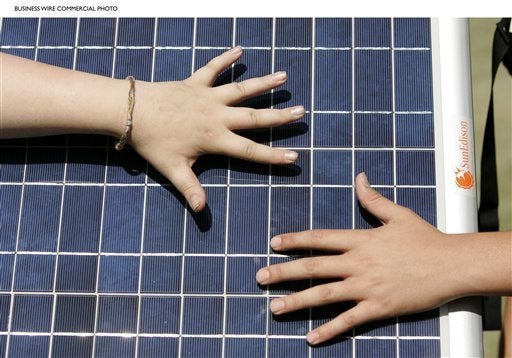
Send all your eco-inquiries to Jennifer Grayson at eco.etiquette@gmail.com. Questions may be edited for length and clarity.
It seems like a good thing that solar is getting popular, but what about all the materials that go into making the panels, recycling them, etc.? Is solar really as green as it's made out to be?
-Griffin
Alas, there's a cloud in every green lining. Just when environmentalists think we've uncovered a win-win solution to some ecological ill, it turns out there's a downside to be dealt with: Compact fluorescent bulbs reduce electricity consumption by 75 percent but come with a dash of mercury; a new Prius takes 46,000 miles of driving before paying off the energy cost of manufacturing (if you make it that far); even tofu, as it turns out, may have a higher carbon footprint than chicken.
It's not surprising, then, that solar panels also have a dark side; namely, greenhouse gases and toxic chemicals involved in manufacturing, and a lack of regulation regarding recycling. First, though, let's take a look at the big picture.
Solar far outshines electricity produced from fossil fuel sources: Per kilowatt, it offsets up to 830 pounds of nitrogen oxides, 1,500 pounds of sulfur dioxide, and 217,000 pounds of carbon dioxide per year. What's more, because photovoltaic (PV) panels generally have a long lifecycle -- up to 30 years -- the amount of waste generated by panels past their prime is relatively small, especially when you consider the three-to-four-year turnover of other electronic waste like computers, televisions, and cell phones.
But with solar growing in popularity thanks to falling prices and various tax incentives, we could see a wave of e-waste in the next 20-some-odd years if the industry doesn't take action now: The Silicon Valley Toxics Coalition (SVTC), which works to promote eco-friendly practices in the high-tech industry, warned in a 2009 report that "little attention is currently being paid to the potential risks and consequences of scaling up solar PV cell production. The solar PV industry must address these issues immediately, or risk repeating the mistakes made by the microelectronics industry."
(Mistakes is a nice way to put it; the United States' failure to regulate e-waste has resulted in our hazardous junk being shipped off to developing nations, where it piles up in digital dumping grounds that pollute the air and groundwater and sicken people who live nearby.)
So what are some of the issues surrounding solar? And how can solar become greener (ironic though that question may be)? Let's take a look:
Toxic chemicals. While it's nowhere near the amount produced by, say, coal-fired power plants, a number of nasty chemicals are used in solar manufacturing, including arsenic, cadmium telluride, chromium, and lead. While one immediate risk may be to the workers who construct these panels, the long-term hazard is where all these materials will go once the panels are no longer useful.
Companies in the US are working to address these concerns, implementing take-back programs like the one offered by thin-film manufacturer First Solar, which recycles over 90 percent of the materials collected from old panels. Another thin-film company, AQT Solar, is looking into safer alternatives to cadmium like zinc sulfide. "Our goal is to definitely reduce our dependence on toxic materials, and if possible, eliminate them completely," says AQT CEO Michael Bartholomeusz.
Greenhouse gases. The whole goal of solar-generated electricity may be to reduce the amount of carbon dioxide going into the atmosphere, but unfortunately, there are even more potent greenhouse gases involved before a panel is ever plugged in. The SVTC report states that sulfur hexafluoride (SF6), which is 22,000 times more powerful than CO2, is used to clean the reactors used in silicon production.
Nitrogen trifluoride (NF3), another global warming whopper (17,000 times more powerful than CO2), is used in the manufacturing of thin-film PV panels. This wasn't an urgent issue a few years back, when thin-film only made up a small percentage of the solar market; but thanks to cheaper manufacturing costs, thin-film is expected to double its market share by 2013. Luckily, alternatives exist: German-based startup Malibu has developed a technology that uses fluorine, a gas with zero global warming potential.
Manufacturing. It would be great if all solar panel production facilities were powered by, well, solar power, but this isn't always the case: The manufacturing side of solar can be very un-green, since its energy-intensive processes are often powered by fossil-fuel based electricity. The need to construct brand-new facilities for production also can add to a solar company's footprint.
One possible solution? Use existing (but dormant) auto-manufacturing plants to house production, a la traditional PV manufacturer Skyline Solar. The company also uses about 90 percent less silicon in its panels compared with traditional solar installations, to help minimize the high environmental cost of silicon production.
So, do any of the above disclaimers mean we should say see ya to solar? Of course not. Even with the energy and waste involved, PV power in exchange for all our fossil fuels would still reduce air pollution and greenhouse gas emissions by 90 percent.
Hope this has been enlightening!
